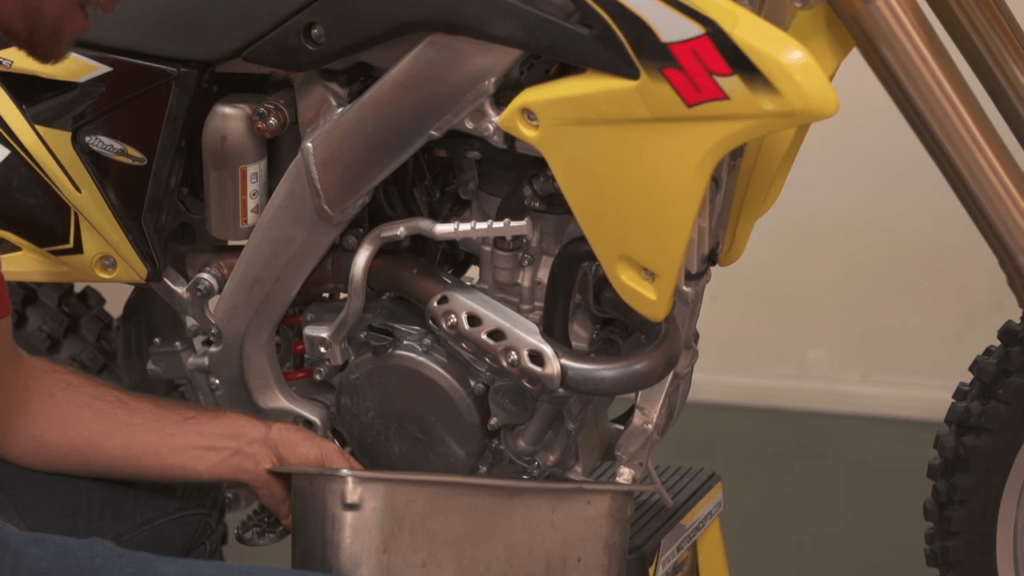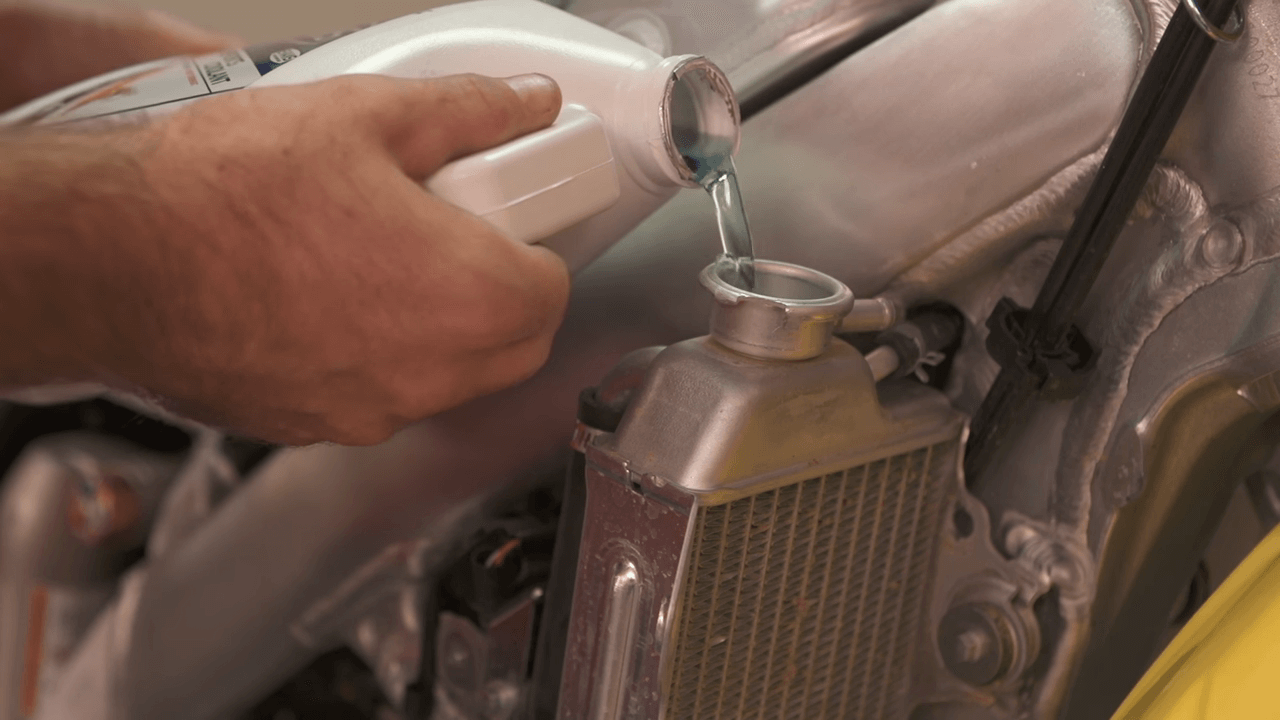Radiators are important for keeping the engines cool and at a moderate temperature so that they can work efficiently, but can you use water in your dirt bike as well just like we do with our car radiators?
You can use distilled water in your dirt bike radiator, but you can use water when you are using water-based coolant in your dirt bike radiator, and if you are not using a water-based coolant then don’t add water.
Most coolants are made up of water, but they also come with additives to increase the boiling point of the water and to prevent any kind of corrosion inside the engine which is made up of metal parts.
And these coolants come with an expiry date as well, so it is recommended to change your motorcycle coolant every year, or after every 10k km. Or you can read the motorcycle owner manual to find the exact timing of changing the coolant because it can vary from model to model.
Especially in dirt bikes, which require more horsepower engines and greater land ride stability. The IC engine of the dirt bike (with an average of 275CC) which produces a huge amount of heat and energy should not be ignored. This can lead to severe issues in the bike, such as failure of engine, poor efficiency of the engine.
As the engine overheats the aluminum material might wrap, swell, expand or even crack. In the cooling of the engines of the bike system Air cooling and Liquid cooling system is most widely accepted worldwide, and in the liquid cooling system Radiators are used and coolants are put in for the cooling of the engine and its enhanced performance.
Table of Contents
Can we use car coolant in a dirt bike?
Coolant basically transfers the heat and adds antifreeze protection to an engine, so that the vehicle can run in optimal condition because too much heat can damage the engine.
The coolants used in cars are mostly Ethylene Glycol-based. So as long as the coolant contains ethylene glycol antifreeze, it can be used in both cars as well as bikes. And the coolant does not contain silicates, as these can be bad for our seal.
Internal combustion engines create energy by burning fuel. Part of this energy is harnessed by the engine and is used to move the vehicle forward. The remaining energy is converted into heat.
A portion of this heat leaves the engine through the exhaust. The rest remains in the engine block itself. The average temperature at which the engine can heat is 2000′ F, and it might touch 4500’F in some instances.
And in all these mostly aluminum is used in engine parts, because of its lightweight and high tensile strength, which melts at around 1225’F. It is the most common cause of engine failure. And to prevent this coolants are used.
If we were to talk about the oils used in cars and bikes they have a strict difference between them. That is, car oil tends to have high amounts of friction modifiers inside of it to help maximize gas mileage in automobiles.
These friction modifiers are bad for motorcycle engines and can lead to clutch slippage given that the friction modifiers inevitably get into the transmission. This means that under no circumstances should you use car oil on a motorcycle.
Coolant is a slightly different story. Obviously, cars and bikes have separate specific coolants. But in some cases, we can use the car’s coolant in bike one. As stated above the coolant must have ethylene glycol antifreeze mandatorily.
This is because some motorcycle enthusiasts that swear up and down using a 50/50 mix of coolant and distilled water work magic inside of their motorcycles.
Additionally, we need to make sure that the car coolant we choose to use does not contain silicates, as these can be bad for our seals. There is definitely silicate-free car coolant on the market, but we have to look specifically for these, given that the majority of car coolants use silicates as they inhibit aluminum corrosion.
Water as a Coolant in the Radiator
Out of the 2 types of cooling systems in the bike, air, and liquid, The benefits of liquid cooling include reducing the effect on the engine from changes in outside temperature for more stable performance and that the coolant also reduces engine vibration and thus lowers mechanical noise.
You can use water as a coolant for a small amount of time, but using water for a long time can damage the engine as it has a low boiling point and it can corrode internal parts of the engine, so always use a coolant with a 50/50 proportion with distilled water, not with tap water.
Tap water contains minerals that can create rusting inside the engine and can damage it very fast. So always prefer the distilled water instead of tap water as it doesn’t contain any kind of minerals.
A liquid cooling system is more complicated than an air one, due to its more complex composition including a radiator, coolant passageways, and piping, etc., its benefit of offering consistent engine power and performance is why liquid cooling is used on so many models.
— Also read: Why do Dirt Bikes have Spoke Wheels instead of Alloys?
Air cooling is nowhere near as efficient as water when it comes to keeping things cool because of water’s high thermal conductivity. If you stream graphically intensive games or render videos and images for a living, you’re likely already pushing your rig and consequently your cooling solution to its limit.
Even if they’re running at safe temps, just being elevated for extended periods will hurt your system after a year or two. Using liquid cooling solutions will not just prolong your hardware’s lifespan but also ensures they’re being cooled efficiently at all times.
How often should we flush the dirt bike radiator?
A dirt bike’s cooling system should be flushed and have the fluids replaced annually. For racing, it is recommended twice per year. The cleaner you can keep your cooling system and the fresher you can keep the fluid, the better its performance will be.
There is no such requirement for using engine ice. For any coolant, a simple solution of distilled water and white distilled vinegar is recommended. Before draining your cooling system, it’s a good idea to add four ounces of aluminum radiator flushing fluid and run your engine for about 10 minutes before draining the system.

It is advised to never uncap your radiator if it’s hot. As a general rule, you risk dangerously hot liquid spraying onto you anytime your engine or radiator isn’t cool enough to touch.
— Also read: Why Dirt Bikes are Better than Quads?
First and foremost, if you’re switching coolants from one brand or type to another, please flush your system with distilled water before the switch. If it’s your first time you might need to guess where to place the drain pan so it catches the stream of liquid but places the pan in correlation to the angle of the flow spout.
Be prepared to move the pan if the stream misses the pan. This is where a second person could be useful as you unplug the radiator cap your helper can assure the pan catches the old coolant.
If you live in an area where temperatures get below freezing you want to use an antifreeze coolant for your dirt bike. Or you can watch this detailed video of how to flush your motorcycle radiator properly.
How to Maintain Your Dirt Bike’s Cooling System?
In a dirt bike, radiators are located at a very crucial position i.e. just behind the front wheel. This is the most vulnerable place to be hit by pebbles, sticks, or mud splashes, while riding, which might destroy the radiator.
So for that, the radiator must be checked and monitored after every ride and cleaned properly. The container containing the distilled water should be kept at a high level and have no leaks or air bubbles.
Remember that it is completely up to you as to how often you clean and maintain your cooling system. A liquid cooling system is an extra component in the complex puzzle that is your PC and you should consider this before buying one for the aesthetic glee.
Take care to regard its twisting body and the maintenance that is required of it before diving in head-first.
